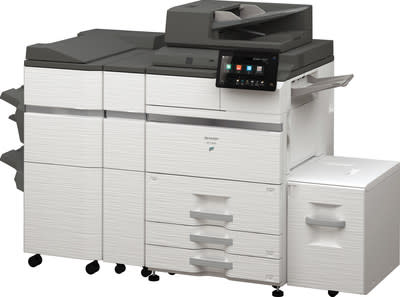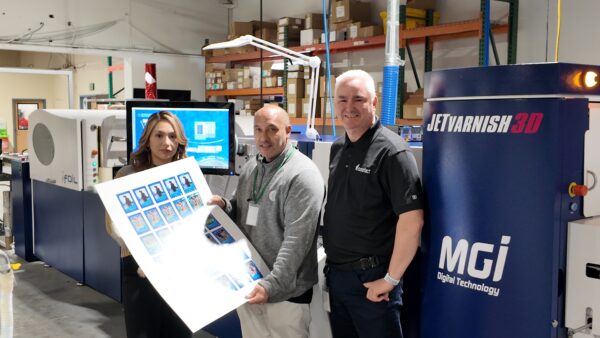The latest models offer greater flexibility, convenience, and enhanced security.
A3 devices, the too-much-is-never-enough workhorses of office printing, have long been the go-to machines for customers seeking a full set of features and capabilities. As is often the case with technology, some have the latest iterations of existing features, but this doesn’t mean customers should wait for the next model. New versions frequently have refined or enhanced editions of previous features, adding functionality that previous models lacked. All are capable machines that solve real-world problems and address common needs.
The Evolving A3 Landscape
Every OEM rolls out new products with features based on what they hear from office technology dealers and customers who have bought devices directly. Listening to such input encourages the inclusion of features that make A3 machines quieter, more efficient, and easier to set up, service, and use. Some features, such as antivirus protection, are increasingly common across all vendors. Others, like Konica Minolta’s latest offerings, enable you to configure the A3 device to meet customer preferences.
“Modularity, exemplified by versatile configurations, outstanding image quality, and exceptional security as both standard and options, are part of our A3 line,” said Maria Krawsek, manager for digital workplace & office products at Konica Minolta Business Solutions U.S.A.
No one will contest the importance of smooth paper paths through a machine. Roller height adjustment on the bypass paper feeder and the bypass paper feed retry control are features Konica Minolta has included on some machines to ease the flow of paper. Similarly, HP’s “Reverse & Retry” feature can reportedly reduce multi-feed problems in automatic document feeders. Such productivity enhancements help keep jobs flowing while eliminating or reducing service calls related to this issue.
Speaking of HP, the company’s FutureSmart firmware allows dealers to provide customers with the latest technology, including software upgrades, without requiring new hardware purchases. HP also uses a new ASIC processor to enable faster processing and OCR speeds, as well as shorter start-up times. Dealers also may appreciate HP’s new Cartridge Access Control, which allows them to lock the cartridge access door to reduce premature removal and replacement of cartridges. According to HP, this can improve the overall cost of a contract by reducing waste and the costs associated with premature cartridge removal while helping customers get the greatest yield from toner. HP’s latest A3 devices also have a new industrial design, with color options for the front panel. This may sound like colors on a car, but it allows the device to blend into customer environments.
Kyocera Document Solutions America’s A3 machines also are embedded with intelligent software applications, making the devices easier to use. The company’s machines have a single driver, which supports various machines, fax server integration, ID card scanning, multiple cropping, and more.
Ricoh A3 devices offer new advanced finishing capabilities, including booklet making, hole punching, stapleless binding and folding, higher volume capabilities, heavier-weight media support, and some deep security measures, which we’ll get to shortly.
Vendors are well aware of the broad societal concern of sustainability. Ricoh, while every bit as conscious of shifts in technology as other OEMs, has recognized the importance of sustainability and was the only vendor to cite it as a feature and benefit of its A3 printers.
“Most A3 devices are very good at what they are designed to do, and there has been a lot of improvement in recent years in sustainability,” said Chris Markowski, director of portfolio management at Ricoh USA. “Many of our A3 products contain significantly more post-consumer content than previous generations and often have lower energy consumption values than many A4 products.”
Security = A Key Selling Point
As you might expect, security is a top-of-mind issue for many dealers’ customers. Here, the cloud plays a key role. Konica Minolta’s approach includes enhanced virus scanning and detection of attacks on authentication and passwords. Vendors are emphasizing the importance of cloud security and authentication software, which are vital capabilities in a time when reliable collaboration is critical to success.
HP’s FutureSmart firmware is available on most HP devices. Security features include encrypted hard drives, secure boot-up, whitelisting, and run-time intrusion detection. These help protect sensitive information and prevent unauthorized access. FutureSmart also provides printer-level integration with Microsoft Universal Print, Sharepoint, and OneDrive. This makes both security and collaboration easier to implement across many people in today’s remote work environments.
Sharp Imaging and Information Company of America also is paying attention to firmware. “Our new A3 devices have remote firmware updates to keep devices secure, and ConnectWise SIEM service provides security alerts for enhanced security and rapid response,” said Andre Pimentel, product marketing manager at Sharp.
The company also addresses the need for collaboration among coworkers, regardless of location. “Microsoft Teams, Google Drive, and Dropbox integration enable collaboration among workers, no matter where they are,” noted Naeran Rubio, associate director, content & communications at Sharp.
Ricoh’s Always Current Technology (available on its IM series products) provides customers with periodic updates and ongoing value. Some models support recent security standards, including Transport Layer Security (TLS) 1.3, which assists in meeting various regulatory and compliance requirements. Common Criteria certification and support for many of the controls within NIST SP 800-171 demonstrate a focus on meeting recognized security standards. Created because cybersecurity and information protection are not intuitive, NIST is not a one-size-fits-all widget. It’s more than 120 pages about how information should flow throughout a company. Ricoh is protecting dealers and their customers by including the parts that matter in its A3 devices.
Toshiba’s A3 line includes security features that safeguard users from existing threats. These include a Trusted Platform Module (2.0), anti-malware, and a solid-state drive with integral encryption, which ships as standard equipment in Trade Agreement Act–compliant models.
“We offer a complete CAC/PIV [Common Access Card / Personal Identity Verification] solution, which provides the strongest authentication measures in use by many segments of the U.S. government,” explained Robert Covington, senior product manager at Toshiba America Business Solutions. For dealers, this opens opportunities for addressing the needs of government agencies in the General Services Administration markets where high-security levels are expected.
Toshiba’s latest models have built-in authentication with Microsoft Entra-ID, a cloud-based identity and access management solution. This translates into fewer hardware purchases and reduced software management. Some security features include the built-in TPM Trusted Platform Module 2.0 module and built-in anti-malware within the device.
“These features are standard on our models and optional for some other manufacturers,” added Manny Sahu, Toshiba’s director of technology marketing.
Other cloud-enabled capabilities aren’t limited to security. Dealers can adjust some settings remotely and perform service tasks that once required an onsite visit. Your tech team is probably already taking advantage of this on existing machines, letting you deploy service techs more efficiently while customers can increase printer uptime.
Also worth considering, partly because it is a selling point, is end-of-lease data erasure to protect privacy at trade-in time. You can probably think of a few customers who might value this offering. Ask your OEMs what their A3 devices offer so you’re prepared when a customer asks what happens to the 28 terabytes of data sitting on the solid-state drives inside the printer you sold them.





